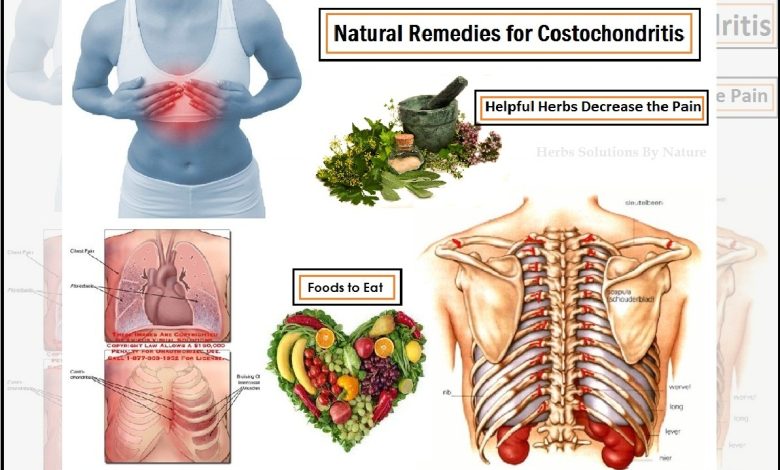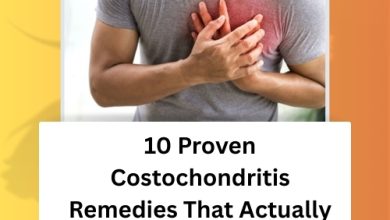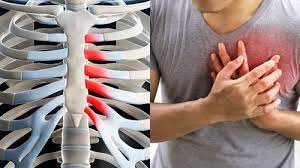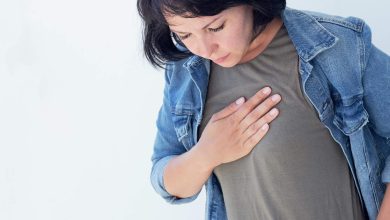Costochondritis Treatment Natural Remedies Decrease the Pain

Natural Remedies for Costochondritis
Costochondritis is inflammation of the cartilage connecting your ribs to your sternum (breastbone). The pain can feel like the sharp, stabbing or pressing, aching pain of a heart attack. You should seek emergency medical care if you have any heart attack symptoms. However, if your diagnosis is costochondritis, it is generally considered a harmless condition. Conventional costochondritis treatment and natural remedies may work well together, too. Always consult a healthcare professional before starting or changing a treatment, exercise or diet plan — including herbs and supplements. Many Natural Remedies for Costochondritis can interact with NSAIDs, insulin or other common medications.
Herbal Remedies for Costochondritis
Herbal treatments for this condition may help reduce your costochondritis-related pain and inflammation. Discuss the efficacy and safety of herbs with your doctor before using these substances. We will detail the various natural remedies for costochondritis, including the best costochondritis diet and some of the better Costochondritis Treatment Natural Remedies. The following strategies may help cure costochondritis fast.
Helpful Herb
Arnica may be a helpful herb in treating your costochondritis, due to its ability to reduce inflammation and treat pain. Arnica, notes expert herbalist Ed Smith, author of “Therapeutic Herb Manual,” is a powerful anti-inflammatory agent that is used in treating a wide variety of musculoskeletal problems. This herb may be beneficial in treating pain in your joints, muscles, ligaments and other soft tissues. Various parts of the arnica plant contain flavonoids and essential oils that are used in herbal medicines.
Decrease the Pain
There are also a variety of herbal remedies used as Herbal Treatment for Costochondritis that help reduce pain and inflammation of the affected area. These natural herbal remedies for costochondritis are commonly used to decrease the pain:
Rest
You may need to rest and avoid painful movements and activities. Do not carry objects, such as a purse or backpack, if this causes pain. Avoid activities such as weightlifting until your pain decreases or goes away. Ask your healthcare provider which activities are best for you to do while you recover.
Heat
The heat helps decrease pain in some patients. Apply heat on the area for 20 to 30 minutes every 2 hours for as many days as directed.
Ice
Ice helps decrease swelling and pain. It may also help prevent tissue damage. Use an ice pack, or put crushed ice in a plastic bag. Cover it with a towel and place it on the painful area for 15 to 20 minutes every hour or as directed.
Stretching Exercises
Gentle stretching may help your symptoms. Stand in a doorway and put your hands on the door frame at the level of your ears or shoulders. Take 1 step forward and gently stretch your chest. Try this with your hands higher up on the doorway.
Home Remedies for Costochondritis
The following home remedies may provide relief from costochondritis:
- Taking pain relievers such as nonsteroidal anti-inflammatory medications like ibuprofen (Advil, Motrin) or naproxen as needed.
- Doing stretching exercises.
- Avoid strenuous activities.
- Lastly, make sure your teen gets plenty of rest.
- Using local heat or ice to relieve pain.
- Avoiding unnecessary exercise or activities that make the symptoms worse; avoiding contact sports until there is an improvement in symptoms, and then returning to normal activities only as tolerated.
- You can put a warm or cold pack on the sore area of your child to feel better.
If the chest pain is due to muscle strain your child should avoid weight lifting.
Foods to Eat
In general, an anti-inflammatory diet can help transform your health while reducing both pain and inflammation in problems such as costochondritis. This type of diet is full of foods that contain antioxidants, vitamins, minerals, and essential fatty acids.
Some of the better anti-inflammatory foods include:
- Green leafy vegetables like spinach or kale
- Bok choy or other Brassica vegetables like cabbage or broccoli
- Nuts and seeds like walnuts or pumpkin seeds
- Bone broth and other animal products like grass-fed meats and wild-caught fish
- Healthy fats like chia seeds, flaxseed, coconut oil, and avocado
- Anti-inflammatory spices and herbs like ginger and turmeric
- Berries like strawberries, raspberries, and blueberries
- Sulfur-containing foods like garlic and onions
- A variety of other colorful whole food choices such as celery, beets, noni fruit, and pineapple
- Also, consume plenty of filtered water, smoothies, and freshly squeezed vegetable and fruit juices.
Foods to Avoid
- On the other hand, an anti-inflammatory costochondritis diet excludes a number of pro-inflammatory foods and substances. For instance, be sure to stay away from refined grains, refined sugars, and processed foods, specially packaged snacks, bread, baked goods, and soda.
- Dairy and gluten-containing foods are also thought to cause inflammation. Alternatively, consider dairy-free products like coconut, rice, or almond milk, and gluten-free products that contain rice or quinoa. Also, avoid stimulants like alcohol and caffeine, which are known to worsen inflammation.
Lifestyle Changes
Your doctor may tell you to make permanent lifestyle changes if you have persistent or chronic costochondritis. Some types of exercise can aggravate this condition, including running and weightlifting. Manual labor can also have a negative effect.
Your doctor may also recommend:
- Bed rest
- Physical therapy
- Hot or cold therapy using a heating pad and ice
- Your doctor may use pain levels to evaluate your response to treatment. Once you’ve finished treatment, you can gradually build up to your previous activity levels. Daily stretching can help relieve some pain.
- Your doctor can also perform a procedure called transcutaneous electrical nerve stimulation (TENS), which uses small amounts of electricity to stop your nerves from sending signals of pain or aching to your brain.
Costochondritis is medical jargon for acute inflammation of the costal cartilage. Although sometimes the problem can disappear on its own, other times, it can linger for weeks and even months. That is why it is important to understand many of the natural remedies for costochondritis mentioned in this article.
Some of the better natural remedies for costochondritis include rest, heat or cold compress, stretches and exercises, improving your posture, and herbal remedies like arnica. The anti-inflammatory costochondritis diet might also help you heal your pain and inflammation in both the short-term and long term. Herbs Solutions By Nature recommend further treatment such as an herbal supplement.
Resources Link:
https://draxe.com/health/inflammation/costochondritis/
https://www.webmd.com/pain-management/qa/what-are-some-home-remedies-for-costochondritis
https://www.livestrong.com/article/397133-herbal-treatment-for-costochondritis/
https://www.drugs.com/cg/costochondritis.html
https://www.momjunction.com/articles/effective-home-remedies-to-cure-chest-pain-in-teenagers_0096279/#gref
https://www.doctorshealthpress.com/pain-articles/costochondritis-cure-treatment-tips-diet/
Related Information:
Natural and Effective Remedies for Costochondritis
5 Herbal Treatments for Costochondritis Chest Pain






